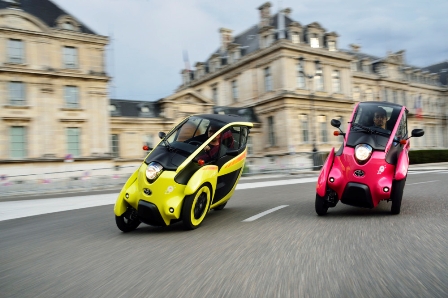First shown in concept form at the 2013 Geneva motor show Toyota’s personal mobility vehicle (PMV) the i-Road has been transformed into a road-legal version – capable of circumventing city congestion and creating enhanced mobility.
 PMVs are a new, more flexible type of transport for urban driving that is significantly more comfortable, weatherproof, stable and safe than scooters and motorcycles. While they share the zero-emissions and low running cost virtues of electric vehicles, their dimensions – in particular their width – are similar to a conventional two-wheeler, giving them the essential manoeuvrability needed for negotiating city traffic and easy parking.
PMVs are a new, more flexible type of transport for urban driving that is significantly more comfortable, weatherproof, stable and safe than scooters and motorcycles. While they share the zero-emissions and low running cost virtues of electric vehicles, their dimensions – in particular their width – are similar to a conventional two-wheeler, giving them the essential manoeuvrability needed for negotiating city traffic and easy parking.
For the first time the i-Road vehicle has touched down on African soil – as part of a personal mobility demonstration at Toyota’s State of the Motor Industry (SOMI) address held in Midrand, Gauteng.
Design
Toyota has refined the design of the original i-Road concept to improve visibility, weatherproofing, manoeuvrability and general user-friendliness. The doors have gained manually operated windows, making i-Road completely weatherproof and giving it a considerable advantage over conventional two-wheelers in that it can be driven without a helmet or protective clothing in all weather conditions.
The rear has been redesigned with a reduced overhang, restyled and repositioned combination lamps and a small rear window. There is a choice of five bright colours for the bodywork.
The revised Toyota i-Road measures 2,345m long, 1,455mm high and 870mm wide, and has a 1,695mm wheelbase. This makes it 5mm shorter than the concept, 10mm higher and 20mm wider – dimensions that remain ultra-compact.
This means it can be driven smoothly along roadsides and down narrow alleys. Up to four i-Road can be parked in a single standard parking bay.
Power
 The full electric powertrain is unchanged: a lithium-ion battery powers a pair of 1.9kW electric motors mounted in the front wheels. With brisk acceleration and near-silent running, i-Road has a driving range of around 50km (target distance at a fixed 30km/h). A full recharge from a conventional household power supply, takes just three hours.
The full electric powertrain is unchanged: a lithium-ion battery powers a pair of 1.9kW electric motors mounted in the front wheels. With brisk acceleration and near-silent running, i-Road has a driving range of around 50km (target distance at a fixed 30km/h). A full recharge from a conventional household power supply, takes just three hours.
Toyota’s new, entirely intuitive Active Lean technology is key to i-Road’s higher levels of stability, safety, comfort and enjoyment. Working in conjunction with rear-wheel steering, controlled by a conventional steering wheel, the system has a lean actuator motor and gearing mounted above the front suspension member and linked via a yoke to the left and right front wheels.
An ECU calculates the required angle of lean, based on steering angle, vehicle speed and information from a gyro sensor. The system automatically moves the wheels up and down, in opposite directions, and can apply a lean angle to counteract the centrifugal force of cornering.
The system also operates when i-Road is being driven straight ahead on a stepped surface, the lean actuator automatically compensating for changes in the road surface to keep the body level.
Active Lean technology gives a unique driving experience, with all the enjoyment of two-wheeler riding, exceptional manoeuvrability and a minimum turning circle of just three metres, yet with no need for the driver to keep the vehicle stable at low speeds, or when stationary.
The fact the driver doesn’t have to put his or her feet on the road surface at any time allows i-Road to have a safer, weatherproof, closed body construction. Not only does this mean the driver doesn’t have to wear a helmet, there is a more car-like environment inside, with the opportunity to install heating, an audio system and Bluetooth.
Three-year test programme in Grenoble, France
Urban transport of the future became a reality in the French city of Grenoble, where a partnership between Toyota, the local authorities, EDF, Sodetrel and Cité-lib conducted a three-year trial targeting improvements in the efficiency and effectiveness of public transport systems by interconnecting them with electric PMVs.
Toyota supplied 35 i-Road (and 35 four-wheeled electric COMS vehicles) to the project and contributed its Ha:Mo (harmonious mobility) system to manage the scheme day-to-day, following a model that’s already been successfully trialed in Toyota City in Japan.



